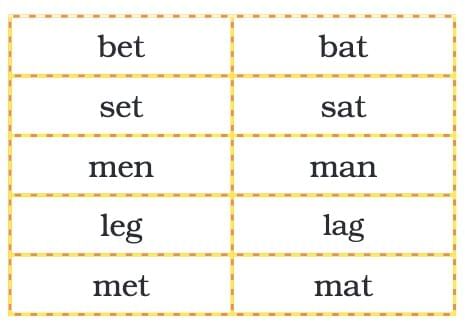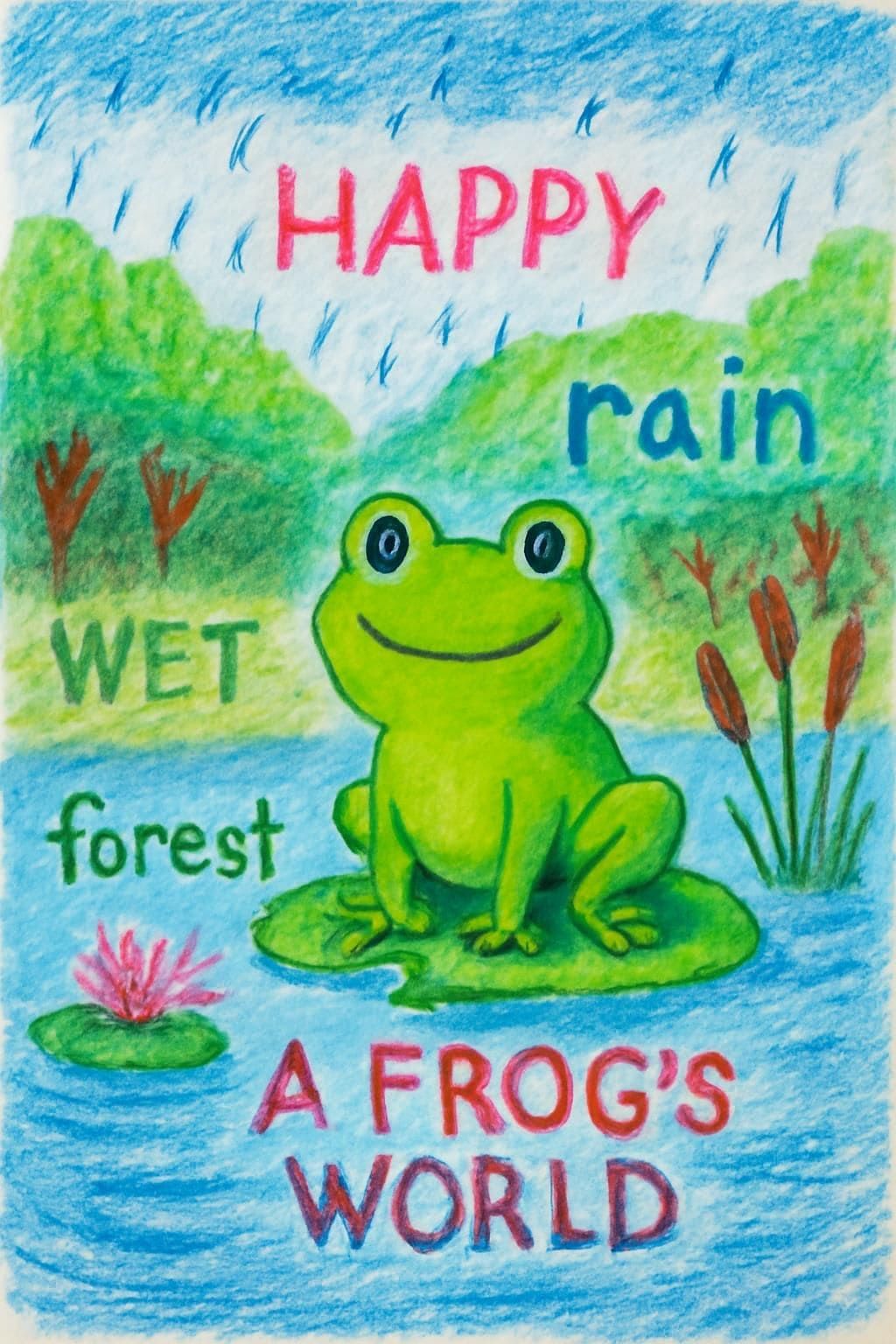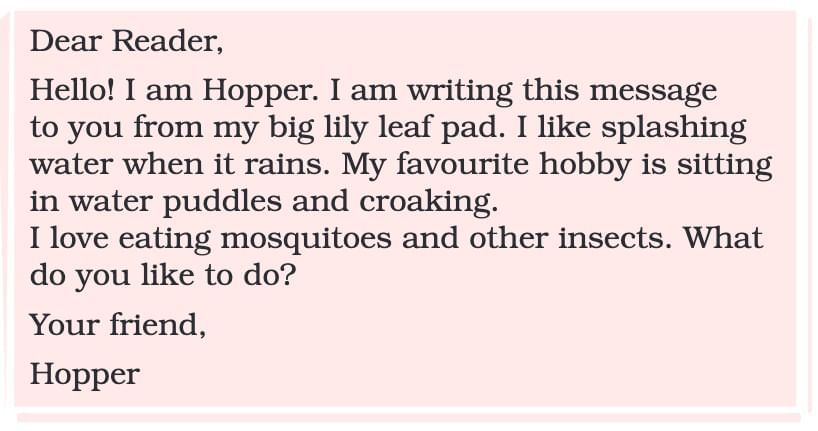The Frog NCERT Solutions | English Santoor Class 5 - New NCERT PDF Download
| Table of contents |

|
| Let us Think (Page 56) |

|
| Let us Learn (Page 57) |

|
| Let us Speak (Page 58) |

|
| Let us Listen (Page 59) |

|
| Let us Write (Page 61) |

|
Let us Think (Page 56)
A. Answer the following questions
Q1: Where does the frog like to sit or spend time?
Ans: The frog likes to sit in ponds, in the rain, or in a muddy drain.
Q2: How does the frog catch its food?
Ans: The frog catches its food by flicking its tongue quickly.
Q3: How does the frog move in water and on land?
Ans: In water, the frog swims with its webbed feet. On land, it hops and jumps high.
Q4: What helps the frog hide in its surroundings?
Ans: The frog’s colours, which match plants and trees, help it hide in grass and leaves.
B. Think and discuss
Q1: What would it feel like to live like a frog, both in water and on land?
Ans: Living like a frog would feel fun because I could swim in water and hop on land. It would be exciting to live in wet places but scary to watch out for snakes.
Q2: If you could hop as high as a frog, what fun things would you do?
Ans: If I could hop like a frog, I would jump over puddles, play high jumps with friends, and hop to the tops of small trees for fun.
Q3: How is a frog’s life different from a fish’s life?
Ans: A frog lives on land and in water, hopping and swimming, while a fish lives only in water and swims. Frogs eat insects with their tongue, but fish eat food in the water.
Q4: How are frogs’ webbed feet similar to the flippers used by scuba divers?
Ans: Frogs’ webbed feet and scuba divers’ flippers are similar because both help them swim easily in water by pushing against it.
Let us Learn (Page 57)
A. Choose the correct words from the brackets and fill in the blanks.
1. My colours match the plants ............... trees.(or/and)
2. Would you like to learn about frogs ...............tadpoles? (because/and)
3. I hop around happily, ............... I must watch out for snakes! (but/so)
4. Frogs swim easily ............... they have webbed feet. (because/or)
Ans:
1. My colours match the plants and trees.
2. Would you like to learn about frogs and tadpoles?
3. I hop around happily but I must watch out for snakes!
4. Frogs swim easily because they have webbed feet.
B. The following words have been rearranged into sentences. Choose the correct option.
1. hunts/night/the/silently/tiger/at
Options:
a. The tiger hunts silently at night.
b. Tiger hunts the silently at night.
c. Hunts the tiger at night silently.
2. elephants/in/forests/live/large/groups/in
Options:
a. Elephants live large in groups forests.
b. In groups large, elephants live in forests.
c. Elephants live in large groups in forests.
3. web/a/spider/carefully/its/weaves
Options:
a. A spider carefully weaves its web.
b. Spider carefully weaves its web a.
c. Carefully a spider weaves web its.
4. crocodile/waits/the/silently/riverbank/the/near
Options:
a. Crocodile waits the silently the near riverbank.
b. The silently crocodile waits near the riverbank.
c. The crocodile waits silently near the riverbank.
5. a/swims/turtle/slowly/in/ocean/the
Options:
a. A turtle swims slowly in the ocean.
b. Swims turtle slowly an ocean in.
c. The ocean swims a slowly turtle in.
Ans:
1. a. The tiger hunts silently at night.
2. c. Elephants live in large groups in forests.
3. a. A spider carefully weaves its web.
4. c. The crocodile waits silently near the riverbank.
5. a. A turtle swims slowly in the ocean.
Let us Speak (Page 58)
A. Three tongue twisters are given below. Try speaking each tongue twister slowly at first. Gradually increase your speed with each repetition. Count how many times you can say it correctly without making a mistake.
This is a classroom activity. Practice saying the tongue twisters:
1. Four fierce frogs fight for flies.
2. Fast frogs flip-flop across fluffy fields.
3. Funny frogs flap floppy feet.
Start slowly, then say them faster, and count how many times you say them correctly.
B. Listen and repeat.
Your teacher will say aloud the following pairs of words. Listen carefully and repeat each pair.

Let us Listen (Page 59)
A. Your teacher will read out instructions for you to follow and create your own 'Frog’s World'.
1. Draw the place: Imagine a place where your frog might be happy, like a pond, a forest or a rainy area.
2. Draw your frog: Draw a frog in the above setting.
3. Decorate with words: Around your drawing, write some words from the poem that describe the frog’s life. You can even write your own short sentence about the frog’s world.
4. Colour it: Use colours to bring your frog’s world to life! Be creative and make it as colourful as you would like.
1. Draw a pond, forest, or rainy area.
2. Draw a frog in that place.
3. Write words from the poem like “hop,” “croak,” or “webbed” around the drawing.
4. Colour the drawing to make it bright and lively.

Let us Write (Page 61)
Here is a message for you from Hopper, the frog.

Dear Hopper,
Hello! I’m happy to get your message from your lily leaf pad. I like playing games with friends and eating snacks like chips. Splashing in water sounds fun! I also like reading books and running in the park. Do you hop high in your pond? Your friend, [Your Name]
|
40 videos|489 docs|63 tests
|
FAQs on The Frog NCERT Solutions - English Santoor Class 5 - New NCERT
| 1. What are the main characteristics of frogs that make them unique in the animal kingdom? |  |
| 2. How do frogs contribute to their ecosystems? |  |
| 3. What adaptations do frogs have for survival? |  |
| 4. What is the life cycle of a frog? |  |
| 5. Why are frogs considered indicators of environmental health? |  |




















